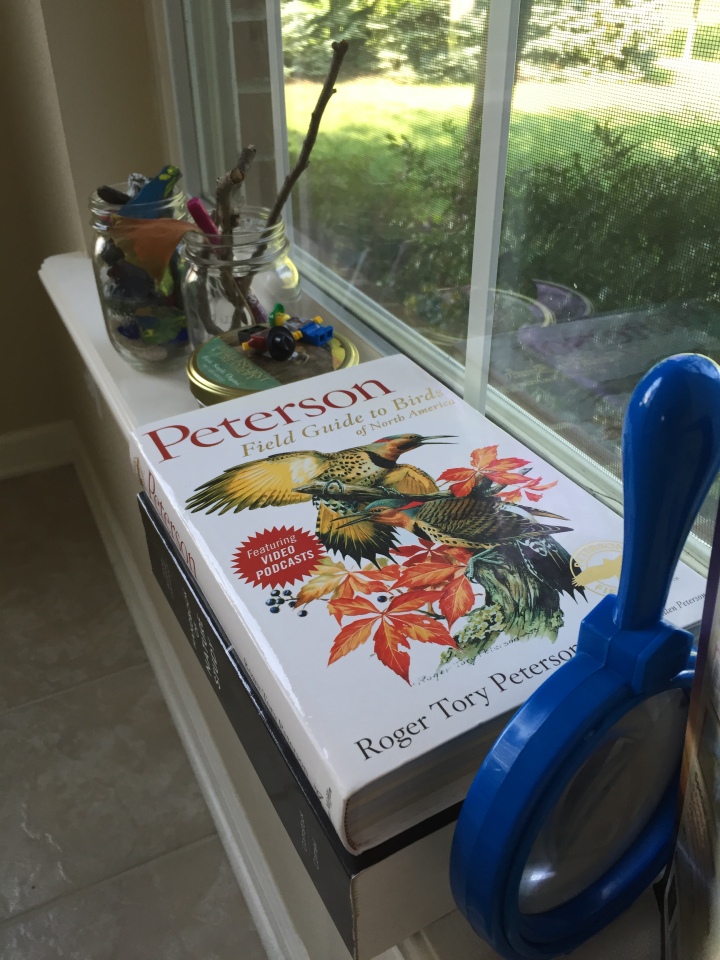 Sometimes it is difficult to plan out every single academic subject. As long as I have a solid idea where we are with Math and Language Arts, the other subjects can live in a state of flux at times. While I might want S’s curriculum a little more focused and firm in content, this is particularly true for G’s lessons. We might use our Magic School Bus science kit for a couple of weeks, abandon it for a human anatomy book the next week, and finally just not have time for any official science for a few more weeks. I think this is ok when you are six. Science is around us, and our backyard and sun room have provided us with automatic sources for nature studies.
Sometimes it is difficult to plan out every single academic subject. As long as I have a solid idea where we are with Math and Language Arts, the other subjects can live in a state of flux at times. While I might want S’s curriculum a little more focused and firm in content, this is particularly true for G’s lessons. We might use our Magic School Bus science kit for a couple of weeks, abandon it for a human anatomy book the next week, and finally just not have time for any official science for a few more weeks. I think this is ok when you are six. Science is around us, and our backyard and sun room have provided us with automatic sources for nature studies.
One of the first things we did after moving in to our current home just over a year ago was to set up a few bird feeders outside our sun room windows. I have written about the amount of time we spend watching all our feathered friends. Last month G and I printed out several pictures of our favorite birds we tend to see in our neighborhood. We used them to create a poster for our sunroom. G meticulously keeps track of their appearances at the feeders and the trees by placing tally marks as he sights them.

Exploring the nature of the Midwest, its flora and fauna, is the most obvious form of science I can engage in with G. Honestly, it demands little of my time in a season where I feel I need to expend my efforts on other things. A walk through a trees-y trail or wading in a creek and our appetites are enhanced for further study. These have often inspired us in our library choices.
G and I have time on Tuesdays between dropping S off at co-op before his own class begins. It is inconvenient to drive all the way home so we usually pack a few books, read at a cafe or go to a nearby park. Last Tuesday G drew some birds.

Peterson Field Guide to Birds of North America by Roger Tory Peterson and Handbook of Nature Study by Anna Botsford Comstock have become great tools to keep us well informed and asking good questions. G found a great spot under a tree in which to draw his favorite bird, currently the Eastern Bluebird. He is not particularly adept at drawing, so he initially found this task overwhelming in just drawing from a nature book. Then, he remembered YouTube. We found some great little videos taking us step by step in drawing our chosen birds. Here is his Eastern Bluebird. You can find the video we watched here.

G used a very similar one for his Northern Cardinal. Watch it here.

Our geography lessons have us in Central America now, so not only did we find a book filled with gorgeous amphibian photography, but G also included the Panamanian Golden Frog in his nature journal. The Case of the Vanishing Golden Frogs, a Scientific Mystery by Sandra Markle describes the predicament of these brightly colored amphibians and a skin disease that began striking their population in the mid 1990s. We actually found a specific drawing lesson for this particular frog. You can try it here.

YouTube often has a bad reputation for inappropriate content and mindless twaddle, and rightly so, but we try to take advantage of some of the goodness it does offer.












